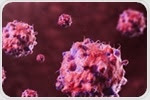|
| | October 10, 2019 | |
| | Cell Biology | |
| | The latest cell & molecular biology news from News Medical | |
|
|
 |
| |  Webinar: Preclinical Bone Imaging using 4D in vivo Micro-CT Webinar: Preclinical Bone Imaging using 4D in vivo Micro-CT
The longitudinal monitoring of murine bone (re)modeling during preclinical research demands the analysis of bone mass and architecture at several time points and involves many animals. In vivo micro-CT surpasses these issues and allows researchers to study the entire bone over time. Learn from real case studies in this webinar, taking place on October 24, 2019.
| |
|
|
|
|
 |
| | Cell death 'blocker' could speed recovery and save lives  Scientists in Australia have shown that they can successfully stop the process of cell death through the use of a revolutionary new compound. This innovation carries huge implications that are likely to change the face of the future of healthcare, most notably, scientists believe they can develop this work to increase patient’s chances of survival following acute injury. Scientists in Australia have shown that they can successfully stop the process of cell death through the use of a revolutionary new compound. This innovation carries huge implications that are likely to change the face of the future of healthcare, most notably, scientists believe they can develop this work to increase patient’s chances of survival following acute injury. | |
|
| | Scientists 3D print full-scale functioning heart components for the first time  Researchers at Carnegie Mellon University in Pittsburgh have developed a new 3D bioprinting method that can produce any part of the heart, from tiny capillaries through to full-scale heart components.Using human cardiac muscle cells, the team could even make a structure that contracts and functions similarly to a real heart. Researchers at Carnegie Mellon University in Pittsburgh have developed a new 3D bioprinting method that can produce any part of the heart, from tiny capillaries through to full-scale heart components.Using human cardiac muscle cells, the team could even make a structure that contracts and functions similarly to a real heart. | |
|
| | Scientists discover how resistant bacteria block entrance of antibiotics  Scientists have discovered how a bacterium that can cause fatal hospital infections evolves to become resistant to antibiotics. The research, carried out by scientists at Imperial College London, has shown that the bacteria close small ‘doors’ in their cell walls to protect themselves against antibiotics in order to continue proliferating in a number of dangerous types of infections. Scientists have discovered how a bacterium that can cause fatal hospital infections evolves to become resistant to antibiotics. The research, carried out by scientists at Imperial College London, has shown that the bacteria close small ‘doors’ in their cell walls to protect themselves against antibiotics in order to continue proliferating in a number of dangerous types of infections. | |
|
| | Parasites could have originated from transmissable cancers  Researchers have presented a controversial new theory suggesting that transmissible cancers could eventually evolve into their own multicellular species. They also say that a peculiar group of marine parasites may serve as living proof of the theory. Until fairly recently, parasites called myxosporeans were thought to be offshoots of the eukaryotic line that is not plant, animal or fungi. Researchers have presented a controversial new theory suggesting that transmissible cancers could eventually evolve into their own multicellular species. They also say that a peculiar group of marine parasites may serve as living proof of the theory. Until fairly recently, parasites called myxosporeans were thought to be offshoots of the eukaryotic line that is not plant, animal or fungi. | |
|
| | Interfacial Protein Monolayers are Strong Enough to Hold a Cell  Human cells adhere to extracellular matrices, such as modified cell culture dish surfaces, and stretch into specific shapes by crawling along the solid support. But how strong does a surface need to be so that the cells do not slip? Scientists from Japan have recently shown that a protein monolayer deposited on a liquid-liquid interface between water and a perfluorocarbon solvent is strong enough for human mesenchymal stem cells (hMSCs) to adhere and spread out. Human cells adhere to extracellular matrices, such as modified cell culture dish surfaces, and stretch into specific shapes by crawling along the solid support. But how strong does a surface need to be so that the cells do not slip? Scientists from Japan have recently shown that a protein monolayer deposited on a liquid-liquid interface between water and a perfluorocarbon solvent is strong enough for human mesenchymal stem cells (hMSCs) to adhere and spread out. | |
|
| | Two cell mutations contribute to the development of acute myeloid leukemia  Sometimes the whole is greater than the sum of its parts. Researchers at Cold Spring Harbor Laboratory have discovered that two cell mutations, already harmful alone, enhance one another's effects, contributing to the development of the deadly blood cancer acute myeloid leukemia (AML). Sometimes the whole is greater than the sum of its parts. Researchers at Cold Spring Harbor Laboratory have discovered that two cell mutations, already harmful alone, enhance one another's effects, contributing to the development of the deadly blood cancer acute myeloid leukemia (AML). | |
|
|
|
|































.png)










No hay comentarios:
Publicar un comentario